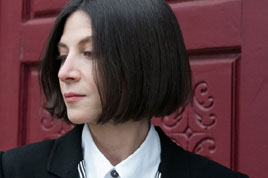Donna Tartt: A Legend In Her Own Lunchtime
Boyd Tonkin on Donna Tartt in The Independent: ". . . Youthful acclaim can block, rather than boost, creative energies. The author of The Great Gatsby -- which was published when he was 28 -- knew that hard truth more bitterly than most. In 1992, another 28-year-old novelist, Donna Tartt, spellbound an equally affluent, equally troubled generation with her debut, The Secret History. Its succulent, calorific blend of Greek orgies, Gothic romance and artful campus comedy helped dig the grave of literary minimalism. . . . The book sparked a bidding war among publishers, spent 13 weeks on the New York Times bestseller list and has sold millions of copies. . . . After this greedily devoured debut came a decade of rumour, and silence, and waiting. . . . But soon the pregnant pause that started when the senior Bush occupied the White House will end. This October, Donna Tartt returns with her second novel, The Little Friend. Ominously, its title as an extended work in progress was 'Tribulation'. . . . At least Tartt has made it to this second hurdle. The story of modern American literature is littered with promising names who fell after the first. . . .. . . Born in 1963, Donna Tartt is the daughter of a local politician, descended from archetypal Southern stock (her mother's family name is Boushé). . . . Aged 13, she published her first poem: a sonnet in a Mississippi magazine. After leaving school she attended the University of Mississippi - 'Ole Miss' in Oxford, the town where William Faulkner transformed Southern fiction. There the Tartt myth started to take shape. The campus writer in residence saw some work and introduced himself: 'My name is Willie Morris and I think you're a genius'. . . . Acclaimed by Morris and the other writer on campus, Barry Hannah, Tartt moved on to develop her precocious skills at Bennington College in Vermont. It's here, amid the northern woods and snows, that the heady cocktail of high art, low hype and coterie self-promotion that marks the cult of The Secret History really begins to mix. At Bennington she met other apprentice authors: Jonathen Lethem, Jill Eisenstadt, Bret Easton Ellis. She blind-dated the latter after the pair swapped manuscripts: a chunk of The Secret History from her, the first chapter of Less then Zero from him. . . . Green-eyed, petite, smartly but androgynously dressed, Tartt read Nietzsche alone in the refectory and cultivated an air of erudite self-possession. This legend in her own lunchtime, and the plot of her novel, appeared in Ellis's second novel -- The Rules of Attraction -- even before The Secret History had gone to the printers. She graduated in 1986 and hooked up a couple of years later with the ICM agency in New York, better known for its showbiz stars. . . . An initial 75,000 print run (enormous by first-novel standards) propelled Tartt on to a national and international round of teasing interviews and public appearances. On this circuit she dazzled many with her confidence -- and dismayed a few with her conceit. Now living in Greenwich Village, the arch, exotic classicist -- a bona fide smoker and drinker, and a dedicated dog-lover - cut a special dash on a scene increasingly peopled by the sort of new-wave Puritan author who would send back a mineral water if it tasted a tad too rich. Then, almost as fast as she had arrived, Donna Tartt disappeared. Or rather, she chose not to play the media games that keep novelists in the public eye between books. Among the varieties of US literary recluse, Tartt ranks more with the Thomas Pynchons (the type that just gets on with life and stays out of sight) than with the rifle-toting, fence-patrolling, writ-throwing species that is exemplified by JD Salinger. . . ."3 A.M. Magazine, November 25, 2002
+ + + Comments + + +



